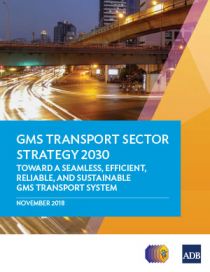New Law Promotes Railway Development in the Lao PDR
The Lao People’s Democratic Republic has issued a law to guide railway development and ensure integration of its rail services with regional and global networks.
Developing transport infrastructure in tandem with policies and procedures for crossing borders and promoting trade has been central to efforts to interconnect the Greater Mekong Subregion countries.
The Subregional Transport Forum reviews, coordinates and monitors regional transport plans and projects of GMS member countries.
Transport lies at the heart of Greater Mekong Subregion cooperation. The development of physical infrastructure, such as roads and bridges, in tandem with policies and procedures for crossing borders and developing trade along key routes, has been central to efforts to forge a truly interconnected subregion.
Physically connecting the countries of the subregion was one of the first initiatives of the GMS program when it was founded in 1992. The countries of the Greater Mekong Subregion have acknowledged that in order to cooperate in trade, tourism, and investment, and to realize the other benefits of the region, they must expand the road links and border crossings that connect them.
This is being done through the development of “economic corridors,” which are geographic areas, often along major highways, where a variety of development projects are undertaken to maximize their development benefits. This might include projects involving infrastructure, laws and regulations, market development, and the improvement of urban centers. Economic corridors bring a wide range of benefits, far beyond what single projects deliver in terms of development impact.
The three main GMS corridors—the East–West, North–South and Southern economic corridors—have improved the lives of millions of people in the Greater Mekong Subregion. These corridors are being enhanced with secondary roads that extend their benefits to nearby communities most in need, and other roads that link to strategic seaports in the subregion. The regulatory details of how people and goods can best move along these corridors are also currently being worked out.
The GMS Economic Cooperation Program Strategic Framework 2030 (GMS-2030) will prioritize intermodal approaches, facilitate cross-border transport, and seek improvement in logistics, asset management, and road safety. Given the rise in GMS economic density, and with respect to its environmental considerations, GMS-2030 aims to ensure the development of railway networks; sea, river, and dry ports; and inland waterways. Investments in airports to improve connections with the rest of Asia and the world will be essential, as will the development of secondary roads that will link to main corridors to expand the benefits to poorer communities. An effort will be made to integrate urban transport with the GMS transport network. GMS-2030 was endorsed and adopted at the 7th GMS Summit of Leaders in September 2021. It aims to provide a new setting for the development of this subregion for the next decade.
Related
• GMS Transport Sector Strategy 2030
• GMS Transport Strategy 2006–2015
Focal Persons at the Asian Development Bank
Steven Schipani
Water and Urban Development Sector Office
Sectors Group
Dee Suvimol Thanasarakij (Ms.)
Executive Director,
Mekong Tourism Coordinating Office
www.mekongtourism.org
Other Concerned Staff & Consultants
Zulfia Karimova, EAPF
Regional Cooperation and Integration Unit
Central and West Asia Department
Mark Bezuijen
Agriculture, Food, Nature, and Rural Development Sector Office
Sectors Group
Asadullah Sumbal
Regional Cooperation and Integration Unit
Southeast Asia Department
Lucia Martin Casanueva
Regional Cooperation and Integration Unit
Southeast Asia Department/GMS Secretariat
Send inquiries to GMS Secretariat.
The Lao People’s Democratic Republic has issued a law to guide railway development and ensure integration of its rail services with regional and global networks.
The People’s Republic of China, Lao People’s Democratic Republic, and Thailand have agreed to build a railway bridge that will be part of a high-speed rail line connecting the three countries.
Cambodia and Thailand reconnected their railroad networks on Monday after 45 years to facilitate cross-border trade and transport.
A new bridge now links the border towns of Myawaddy in Myanmar and Mae Sot in Thailand.
The Government of Viet Nam and the Asian Development Bank (ADB) have signed in March a $188 million loan to improve 198 kilometers of roads in northwestern provinces.
An international seaport project in Southern Cambodia will serve as a gateway for direct ferry services to Viet Nam and later to other destinations in the Gulf of Thailand. The fast ferry services are expected to boost tourism in the Southern Coastal Subcorridor of the Greater Mekong Subregion.
The People’s Republic of China launched last month a high-speed rail service between Yunnan province’s capital Kunming and Lijiang, a tourist destination and UNESCO World Heritage site.
The People's Republic of China is shifting freight transport from roads to railways and waterways, and improving urban logistics systems to reduce carbon emissions.

This new strategy for transport development in the Greater Mekong Subregion consists of a strategic framework covering 2018–2030 and a set of performance indicators initially covering 2018–2022.
HA NOI, VIET NAM (12 December 2018) — The Asian Development Bank has approved a $188 million loan to improve and upgrade 198 kilometers of roads in Viet Nam’s mountainous northwest region, which has the highest poverty rate in the country.